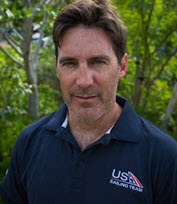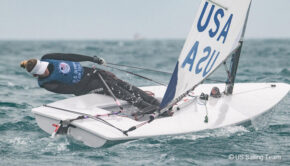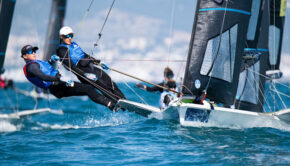Shifting the Direction of US Youth Sailing
Published on December 3rd, 2018
The US Olympic Sailing Program, once a leader at the Olympic level, has undergone a significant re-think during the youth years in hopes of becoming dominant again. Critical to this process has been US Sailing’s Olympic Development Director Leandro Spina.
Spina, who has just been recognized by the US Olympic Committee as the 2018 Developmental Coach of the Year, saw the fruits of his labor at the 2018 Youth World Sailing Championships when the US Sailing Team won The Nations Trophy for their dominating performance across the nine classes.
Scuttlebutt editor Craig Leweck checks in with Spina about the changes and challenges needed to shift the direction of youth sailing.
If you were to pinpoint a year when movement toward a solution began, when would that be and what was it that got the ball rolling?
We had a few early efforts, but things really started moving quickly when the AmericaOne Foundation became involved in 2014. They liked our vision, helped design the strategy and execution plan, and provided the crucial financial support to get things rolling, and Project Pipeline 2024 was born. AmericaOne has been an excellent partner; always engaged to ensure we create a culture of excellence.
Phase 1 of Project Pipeline 2024 allowed our Olympic Development Program (ODP) to work with many young athletes, regional program coaches and US class associations to raise the bar in high performance sailing in the USA. Since then, we have seen incredible improvement in skill in our young talent.
Success has been seen in our international results: the USA won multiple medals and had top performances at Class World Championships, and at the Youth World Championships where we won medals in all disciplines: single-handed, double-handed, skiff, windsurf, and multihull; the most by a single country since 2014.
This outstanding performance at the recent Youth Worlds in Corpus Christi, Texas is a reassurance that we are on the right track, and now, we’re entering Phase 2 of the Project, focusing on transitioning these young athletes into Olympic Classes.
What kind of resistance was faced early on?
Our ODP focus has always been the high performance path. Since there were such strong and successful high school and college sailing pathways in the USA, we had some resistance to the changes we felt important. There were two main areas of focus to change: 1. We needed to develop better crews and; 2. Young sailors needed to sail high performance boats and learn the skills to race them. Both go hand and hand.
We know there is no perfect system, but we believe in the two-event qualifier we’re using for Youth Worlds, and it has proved successful. When Youth Worlds is hosted in December, we plan to use US Sailing’s Youth Championship in June as a qualifier. It’s important for the USA to be aligned with the classes used internationally – especially those sailed at the World Sailing Youth World Championship – so we needed the Youth Champs to include all classes sailed at the Youth Worlds.
We added Windsurfing and Multihull, and replaced C420 with the I420, which of course was a big change. The C420 class is one of the most organized youth classes in the USA and the decision could have been perceived as an action against the sailors, families and people involved with the Class, but the decision was based purely on the belief that our athletes, interested in high performance sailing and/or competing against the best international teams, needed to practice, learn and race in the I420, a boat more technical than the C420.
Now, looking back after four years, both classes have maintained near record participation in the USA, giving athletes and families more options to design their own paths in the sport of sailing. We are pleased we were able to open a new option without closing another one.
Change will always be met with resistance, but it is important to note that despite initial friction, the increased commitment, drive, and dedication from American youth sailors has been the ultimate result, pushing all aspects of the sport.
There is sometimes too much focus on the boats, classes, format, etc. and not enough on the people. We don’t know what will new formats or boat designs the future will bring. Toys will change, but people – the sailors – will always be the most important focus. There is always more work to do, but in focusing on athlete development, we are pushing the needle in the right direction.
What have been some of the critical changes that have occurred?
All the pieces necessary for success exist in the USA: plenty of talented sailors; committed families involved in supportive roles; enthusiastic clubs and coaches, community sailing centers, class associations, equipment suppliers; an amazing education system including high school and college sailing; the best technology hub in the world; incredible sailing venues – the list goes on.
US Sailing is focused on taking a leadership role required to put it all together in a truly collaborative effort, while also allowing all those pieces and stakeholders to grow independently.
I am proud that with the Olympic Development Program, we’ve managed to integrate it all so we are collaboratively working towards the same goals. We not only focus on providing top level coaching and exposing our young talent to some of the best professionals in the sport, but also on sharing best practices around campaign management, time management, goal setting, etc. We created a program where athletes are able to play the sport hard in a safe and fun environment.
For the second half of this interview … click here.










 We’ll keep your information safe.
We’ll keep your information safe.